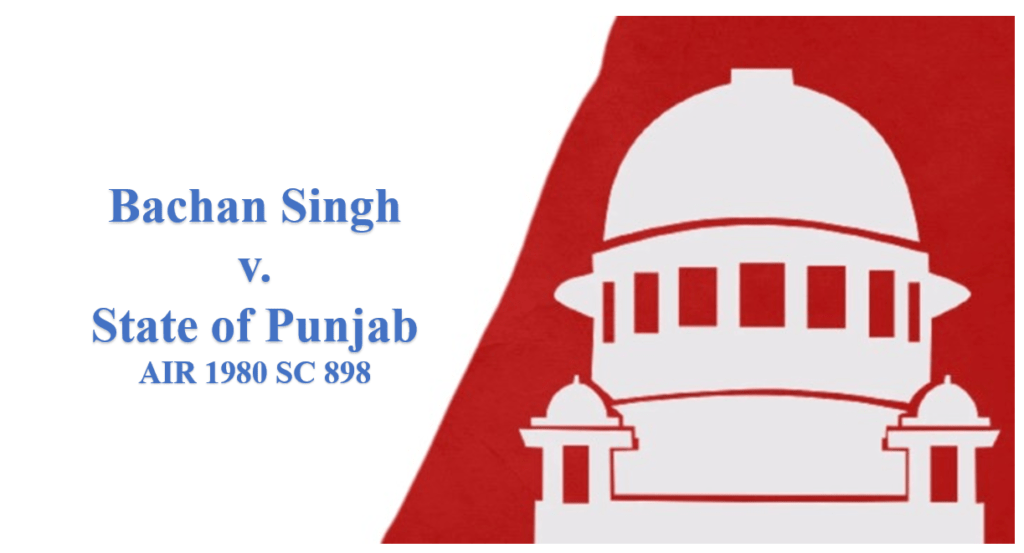
Citation: AIR 1980 SC 898, 1980
Court –The Supreme Court Of India
Bench – Justice Chandrachud, Y.V. Jutice Bhagwati, P.N, Justice Sarkaria, Justice Ranjit Singh, Justice Gupta, A.C., Justice Untwalia, N.L.
Relatable Section / Acts – Section 302 of the Indian Penal Code, 1860, Section 354 (3) of the Code of Criminal Procedure, 1973, Articles 19, 21 of the Constitution of India, 1950, 35th Law Commission Report
ISSUES BEFORE THE COURT-
Whether death penalty provided for the offence of murder in Section 302 of the Penal Code is unconstitutional.
If the answer to the foregoing question be in the negative, whether the sentencing procedure provided in Section 354(3) of the Code of Criminal Procedure, 1973 (Act 2 of 1974) is unconstitutional on the ground that it invests the court with unguided and untrammeled discretion and allows death sentence to be arbitrarily or freakishly imposed on a person found guilty of murder or any other capital offence punishable under the Penal Code, 1860 with death or, in the alternative, with imprisonment for life.”
INTRODUCTION
This Case is a landmark judgment given by 5 judges Bench of the Hon’ble Supreme Court. In this case Supreme Court announced important limitations on the death penalty by setting the “rarest of the rare” doctrine. The Supreme Court said,” A real and abiding concern for the dignity of human life postulates resistance to taking a life through law’s instrumentality. That ought not to be done except in rarest or the rare cases where the alternative opinion is unquestionably foreclosed”.
FACTS
The Appellant Bachan Singh was convicted for his wife’s murder and was sentenced for life imprisonment. After undergoing the term of imprisonment ( i.e after his release) he was living with his cousin Hukam Singh and his family by this Hukamsingh’s wife and his son objected the appellant’s living in their house. A few days prior to this occurrence in the midnight Vidya Bai was awakened by alarm and saw the appellant inflicting axe blow on her sister’s ( Beeran Bai) face. On the attempt to stop the appellant Vidya Bai got blown on her face and ear with axe leading injuries her face and ear making her unconscious. Diwan singh who was sleeping at a distance woke up by the shriek and raised an alarm to wake Gulab singh sleeping at a distance from there. On seeing an appellant with axe on Desabai’s face they both hurried to stop him. Noticing them moving towards him the appellant left the axe and ran away. Diwan Singh and Gulab Singh gave a chase to him but couldn’t apprehend him. Later Bachan Singh was tried and convicted and sentenced to death under Section 302, Indian Penal Code for the murders of Desa Singh, Durga Bai and Veeran Bai by the sessions judge. The High Court confirmed his death sentence given by the sessions judge and dismissed his appeal. Bachan Singh then appealed to the Supreme Court by Special Leave, the Question raised in the appeal was, whether the facts of his case were “special reasons” for awarding him the death sentence as required in section 354(3) of CrPC, 1973.
RATIO OF THE COURT
The Supreme Court by a majority of 4:1 reaffirmed its earlier decision and held that the provision of death penalty as an alternative punishment for murder under section 302 insofar it is neither unreasonable nor it is against the public interest. It violates neither the letter nor the ethos of Article 19 of the constitution of India. It is constitutionally valid. Exercise of discretion under sec 354(3) of CRPC, 1973 should be exceptional and grave circumstances and imposition of death sentence should only be in rarest of rare cases.
Analysis Of the Case
In A.K. Gopalan v. State of Madras [AIR 1950 SC 27: (1950) 1 SCR 88 : 1950 SCJ 174] , all the six learned Judges constituting the Bench held that punitive detention or imprisonment awarded as punishment after conviction for an offence under the Penal Code, 1860 is outside the scope of Article 19, although this conclusion was reached by them by adopting more or less different approaches to the problem. Patanjali Sastri, J., also, opined that lawful deprivation of personal liberty on conviction and sentence for committing a crime, or by a lawful order of preventive detention is “not within the purview of Article 19 at all, but is dealt with by the succeeding Articles 20 and 21”. But later the court finally observed penal laws which define offences and prescribe punishment for the commission of offences do not attract the application of Article 19(1). We cannot, of course, say that the object of penal laws is generally such as not to involve any violation of the rights conferred by Article 19(1) because after the decision of this Court in the Bank Nationalisation case [Rustom Cavasjee Cooper v. Union of India, (1970) 3 SCR 530 : (1970) 1 SCC 248] the theory, that the object and form of the State action alone determine the extent of protection that may be claimed by an individual and that the effect of the State action on the fundamental right of the individual is irrelevant, stands discredited.
In the instant case, the State has discharged its burden primarily by producing for the perusal of the court, the 35th Report of the Law Commission, 1967, and the judgments of this Court in Jagmohan Singh [(1973) 1 SCC 20 : 1973 SCC (Cri) 169 : (1973) 2 SCR 541] and in several subsequent cases, in which it has been recognized that death penalty serves as a deterrent. It is, therefore, for the petitioners to prove and establish that the death sentence for murder is so outmoded, unusual or excessive as to be devoid of any rational nexus with the purpose and object of the legislation.
The court further held that in Jagmohan [(1973) 1 SCC 20 : 1973 SCC (Cri) 169 : (1973) 2 SCR 541] , also, this Court took due note of the fact that for certain types of murders, death penalty alone is considered an adequate deterrent:
The court observed that It will be pertinent to note that most of the countries including those who have subscribed to this international covenant, retain death penalty for murder and certain other crimes even to the present day in their penal laws. Neither the new interpretative dimensions given to Articles 19 and 21 by this Court in Maneka Gandhi [(1978) 1 SCC 248 : (1978) 2 SCR 621] and Charles Sobraj v. Supdt., Central Jail [(1978) 4 SCC 104 : 1978 SCC (Cri) 542 : (1979) 1 SCR 512] , nor the acceptance by India of the International Covenant on Civil and Political Rights, makes any change in the prevailing standards of decency and human dignity by which counsel require us to judge the constitutional validity of the impugned provisions. The international covenant, as already noticed, does not outlaw capital punishment for murder, altogether. For all the foregoing reasons, the court answered the first main question in the negative.
The court while taking note of constitutional validity of section 354 (3) of CrPC observed that the High Court has been given very wide powers under these provisions to prevent any possible miscarriage of justice. In State of Maharashtra v. Sindhi [(1975) 1 SCC 647 : 1975 SCC (Cri) 283 : AIR 1975 SC 1665] , this Court reiterated, with emphasis, that while dealing with a reference for confirmation of a sentence of death, the High Court must consider the proceedings in all their aspects, reappraise, reassess and reconsider the entire facts and law and, if necessary, after taking additional evidence, come to its own conclusions on the material on record in regard to the conviction of the accused (and the sentence) independently of the view expressed by the Sessions Judge.
Similarly, where on appeal, the High Court reverses an acquittal, and convicts the accused person and sentences him to death, Section 379 of the Code of 1973 gives him a right of appeal to the Supreme Court. Finally, there is Article 136 of the Constitution under which the Supreme Court is empowered, in its discretion, to entertain an appeal on behalf of a person whose sentence of death awarded by the Sessions Judge is confirmed by the High Court.
The court further observed that In Jagmohan [(1973) 1 SCC 20: 1973 SCC (Cri) 169 : (1973) 2 SCR 541] , this Court had held that this sentencing discretion is to be exercised judicially on well recognized principles, after balancing all the aggravating and mitigating circumstances of the crime. By “well recognized principles” the court obviously meant the principles crystalized by judicial decisions illustrating as to what were regarded as aggravating or mitigating circumstances in those cases. The legislative changes since Jagmohan [(1973) 1 SCC 20: 1973 SCC (Cri) 169 : (1973) 2 SCR 541] — as we have discussed already — do not have the effect of abrogating or nullifying those principles. The only effect is that the application of those principles is now to be guided by the paramount beacons of legislative policy discernible from Sections 354(3) and 235(2), namely: (1) The extreme penalty can be inflicted only in gravest cases of extreme culpability; (2) In making choice of the sentence, in addition to the circumstances, of the offence, due regard must be paid to the circumstances of the offender, also.
Pre-planned, calculated, cold-blooded murder has always been regarded as one of an aggravated kind.
The court finally observed that Sections 354(3) and 235(2) and other related provisions of the Code of 1973, it is quite clear to us that for making the choice of punishment or for ascertaining the existence or absence of “special reasons” in that context, the court must pay due regard both to the crime and the criminal. What is the relative weight to be given to the aggravating and mitigating factors, depends on the facts and circumstances of the case. Often, these two aspects are so intertwined that it is difficult to give a separate treatment to each of them. This is so because “style is the man”. In many cases, the extremely cruel or beastly manner of the commission of murder is itself a demonstrated index of the depraved character of the perpetrator. That is why, it is not desirable to consider the circumstances of the crime and the circumstances of the criminal in two separate watertight compartments. In a sense, to kill is to be cruel and therefore all murders are cruel. But such cruelty may vary in its degree of culpability. And it is only when the culpability assumes the proportion of extreme depravity that “special reasons” can legitimately be said to exist.
DECISION HELD BY COURT:
In this case the judgment was given by JUSTICE S.K SARKARIA that these are the reasons for which the court made my order dated May 9, 1980 declaring the death penalty provided under section 302 of the 371 Indian Penal Code read with section 354 sub-section (3) of the Code of Criminal Procedure, 1973 is unconstitutional and void as being 5 violative of Articles 14 and 21.
The court expressed the profound regret at the long delay in delivering this judgment, but the reason is that there was a considerable mass of material which had to be collected from various sources and then examined and analyzed and this took a large amount of time. Appeal dismissed.
2.https://indianexpress.com/article/opinion/columns/revenge-isnt-sweet/
3.https://www.project39a.com/op-eds/the-enduring-gaps-and-errors-in-capital-sentencing-in-india
Written by: Rasikh Javed, Jamia Millia Islamia , New Delhi




0 Comments